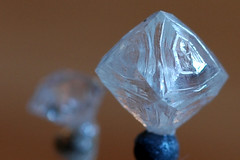 Diamonds are the hardest substance on earth, so it’s no surprise that cutting them is a complicated process. Before any cutting can begin, each stone is carefully studied to determine the grain of the crystal and locate any imperfections. After the diamond’s weak point is found and marked, cutting can begin with a process called cleaving.
Diamonds are the hardest substance on earth, so it’s no surprise that cutting them is a complicated process. Before any cutting can begin, each stone is carefully studied to determine the grain of the crystal and locate any imperfections. After the diamond’s weak point is found and marked, cutting can begin with a process called cleaving.
Cleaving
This part of the cutting process is necessary to bring the rough diamond down to a manageable size. The slightest mistake during cleaving can resulting in the stone’s shattering, a profoundly expensive mistake. At the marked line, the cleaver uses another diamond to make a slight groove. After the diamond is placed firmly into a holder, the cutter sets a steel wedge in the groove. The wedge is struck with a mallet, splitting the diamond along its grain if everything goes smoothly.
Sawing
Some diamonds have no significant weak point along their grain, making safe cleaving impossible. Instead, a cutter uses a paper-thin phosphor bronze saw blade spinning at up to 15,000 revolutions per minute to make the initial cuts. After firmly clamping the diamond in place against the edge of the blade, the saw is covered in diamond dust and set in motion. Throughout cutting, the saw blade recharges itself with more diamond dust from the stone being cut. Four to eight hours are needed for the blade to cut through a single carat of diamond; more time is needed if the blade encounters a knot in the crystal. Lasers are also sometimes used to cut diamonds, but they can take even longer.
Cutting
Cutting, also called bruiting when done by hand, is what shapes diamonds. Hand-cutting starts with placing the diamond to be cut into a cement-filled bowl, with only one corner exposed. By rubbing a diamond against the stone being cut, the crystal’s shape is painstakingly developed. For mechanical cutting, the craftsman secures the diamond on a lathe and another diamond is placed against it to form its shape as the lathe turns. To create different shapes, the diamond is secured at specific angles throughout cutting.
Faceting
After rough cutting is finished, the diamond is faceted by a lapper, who puts the main finishing facets on a diamond. Next, the brillianteer creates and polishes the final facets. This is done by holding the diamond with a mechanical clamp and holding it down with a cast-iron disk charged with diamond dust. This is the most skill-intensive stage of diamond-finishing because the tiny angles and sizes of the many facets must be exact for a truly polished look.
Many shapes can be formed during this process, but the most common is the classic brilliant cut, a round style with 58 facets. Simple-cut diamonds are also round but have just 18 facets. Other styles are called fancy shapes or fancy cuts and vary widely. Some of the most common fancy cuts include oval, pear shape, heart shape, emerald, marquise, baguette, triangle, trilliant and kite.
Polishing
Polishing is the final step in the process. To accomplish this, the cutter mounts the diamond above a spinning polishing wheel coated with diamond dust, smoothing the diamond to ready it for sale.
[photo credit]
Michele Golden is definitely an outspoken and enthusiastic blogger, who likes art, from the great state of Vermont. Shes truly likes searching for loose yellow diamonds. She would want to one day become a diamond merchant or even saleswoman.










Comments